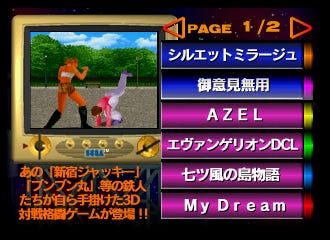Extending the demo: Anarchy In The Nippon
Prototype demos of the Virtua Fighter-inspired fighting game
In this edition:
There are a couple of demos of Goiken Muyou: Anarchy in the Nippon, the goofy 3D fighting game designed by Virtua Fighter enthusiasts.
The demos have superficial limits on which modes and characters you can play, but they can lifted.
Since the demos are based on prerelease builds, there are some interesting differences to the final game.
You can play an extended version of one of the demos - get the patch from SegaXtreme (mirror). Here’s a video!
Intro
Goiken Muyou: Anarchy in the Nippon isn’t terribly well known, but it has its partisans. In a 2010 article, Daniel Thomas MacInnes suggested that it “may be the best polygon fighter ever made for the Sega Saturn.”
I’m not sure about that, but I like this aspect of it: it’s really goofy! In the intro, a conservatively-dressed middle aged woman absolutely demolishes a much younger fighter. You can fight as a middle aged business man with a hairpiece. Four characters are real life Virtua Fighter tournament players who are credited as advisors.
In this article, we’re going to look at Goiken Muyou: Anarchy in the Nippon Taikenban. This is a demo version of the game that gives you access to a subset of the modes and characters. But hidden beyond the demo restrictions is a full build of Goiken Muyou. Furthermore, it’s a prototype version of the game, built a month before the final version (1997-07-09, versus 1997-08-08).
As a bonus, there are two other such demos of this game. Both Tech Saturn 1997-10 and Flash Sega Saturn Vol. 20 have builds from 1997-07-20. They don’t have quite as much stuff, but I’ll point out a few notable things about them below.
Un-restricting the demo
The first thing to do is unlock the missing modes in the Taikenban demo. By diffing memory snapshots, we can find the memory address that holds your menu position. And by setting write breakpoints for that address, we can find the function that handles the mode select screen.
That function (at 06004898) analyzes your controller input. If you press down, it increments your menu position. Then it checks the new position against a table of mode numbers. The demo has some of those marked as FFFF, which the game skips past. All we have to do is change the table (at 06025824) to match the final game’s.
We can do something similar for the character select screen. The cursor will skip over the ones that are crossed out, but if we change the table (at 06047146) referenced by the handling function (at 06047114), we’ll be able to select the rest.
There are actually multiple copies of the character select table in the game files; my patch changes them all.
Now you can play each mode and as all the characters. The modes are:
1 Player
2 Players
Team competition
Watch
Training
Edit fighter
Options
Similar tricks work for the Flash Sega Saturn and Tech Saturn demo menus, but most of the extra modes and some of the extra characters don’t work (presumably because the disc is missing their associated files).
Differences from the final game
The opening intro in the Taikenban demo differs from the final game. In the demo, the characters pose in their levels by themselves. In the final game, they’re fighting each other.
The character select screen is different, too. In the Taikenban demo there aren’t info cards, but the Flash demo and the final version shows you names and stats.
The Taikenban lets you select the “hidden” characters, but doesn’t show their pictures. The Flash demo lets you see them, but is missing their files. The playable game staff characters have different photographs in the Flash / Tech Saturn demo.
Both demos are missing the last item in the Options menu. This one lets you turn on Big Head mode, among other things.
Big Head mode doesn’t seem to be in the Taikenban demo, but it can be activated by setting address 0603f4fb to 01 in the Flash demo (or 0603f34bb in the Tech Saturn demo):
Outro
If you know more about this game, get in touch! I’m sure there are things I didn’t notice about the prototype builds because of the language barrier. If you’re interested in it, see the Sega Saturn Magazine feature on it in November, 1997 issue. That article describes the game as having been designed by “world’s greatest Virtua Fighter players.”
For previous “there’s more to this demo disc” coverage, see the page I’ve started on Hidden Palace.











